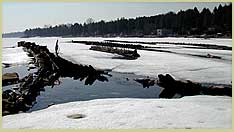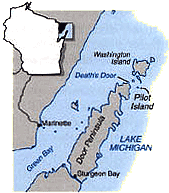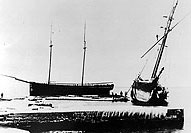
There are over seven hundred shipwrecks in Wisconsin. But why did so many sink? First of all, we need to remember that thousands of ships sailed in and out of Wisconsin's ports. Some older, rundown ships were abandoned in shallow water or intentionally set on fire. Other ships had more exciting endings.

Ships sank for just about every reason you can imagine. Thick fog caused low visibility and ships could run aground or into each other. Captains made mistakes in navigation that caused their ships to sink. Underwater obstacles sank many ships on the Mississippi River and other rivers. Some ships were old and leaky, while others had problems with their engines that caused explosions. But of the many reasons a ship could sink, probably the most terrifying was fire.
In September 1856, the steam-powered ship Niagara left Sheboygan carrying passengers and cargo for port washington. not long after leaving the dock, fire broke out. the engines soon quit, bringing the vessel's giant paddlewheels to a halt. Like many other boats of the day, the Niagara carried no life preservers. The crew began breaking off cabin doors and throwing them, and other buoyant items, into the water. As smoke and flames engulfed the boat five miles offshore, passengers panicked, causing one of wisconsin's deadliest transportation disasters. Despite rescue efforts, over sixty people died.
The phrase "gales of November" is often used to describe the fierce storms that hit the Great Lakes in the late fall. Heavy winds, blinding snowstorms, huge waves, and cold temperatures make October and November the most dangerous time of year for sailors on the Great Lakes. Shipping lanes close during the winter months and don't reopen until spring.

Great Lakes Marine Collection, Milwaukee Public Library/Wisconsin Marine Historical Society
One cold October night in 1891, the schooner Forest entered Death's Door passage at the tip of the Door Peninsula. A gale struck and drove the ship onto the reef at Pilot Island. The next day, the crew rowed to shore and the safety of the lighthouse.
The following fall, two more schooners — the J.E. Gilmore and the A.P. Nichols — wrecked at the same spot less than two weeks apart. On October 17, the Gilmore entered the passage in heavy, shifting winds and was blown onto the reef. The crew waited out the storm on board. On October 28, fierce winds and blinding snow struck the Nichols, tore apart her rigging, and drove her onto the rocks near the shipwrecked Gilmore and the Forest. In a dangerous rescue, the lighthouse crew helped the sailors leap from the rolling Nichols onto the icy deck of the wrecked Forest in order to reach Pilot Island. Because of the bravery of the lifesaving crew, not one person was lost in all three wrecks!
